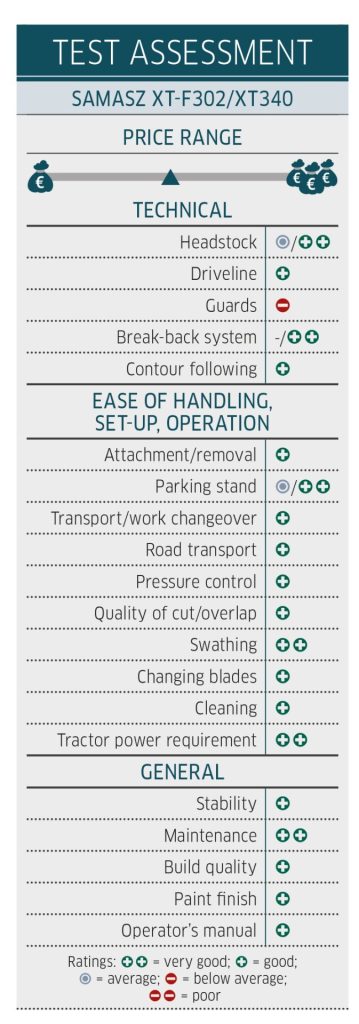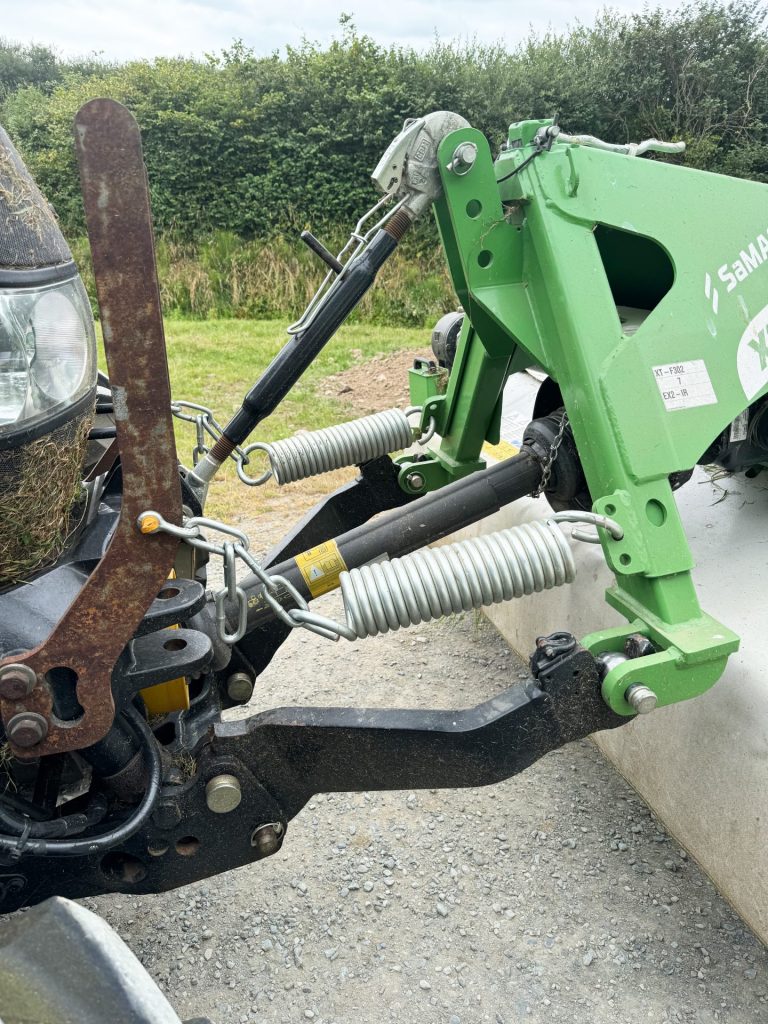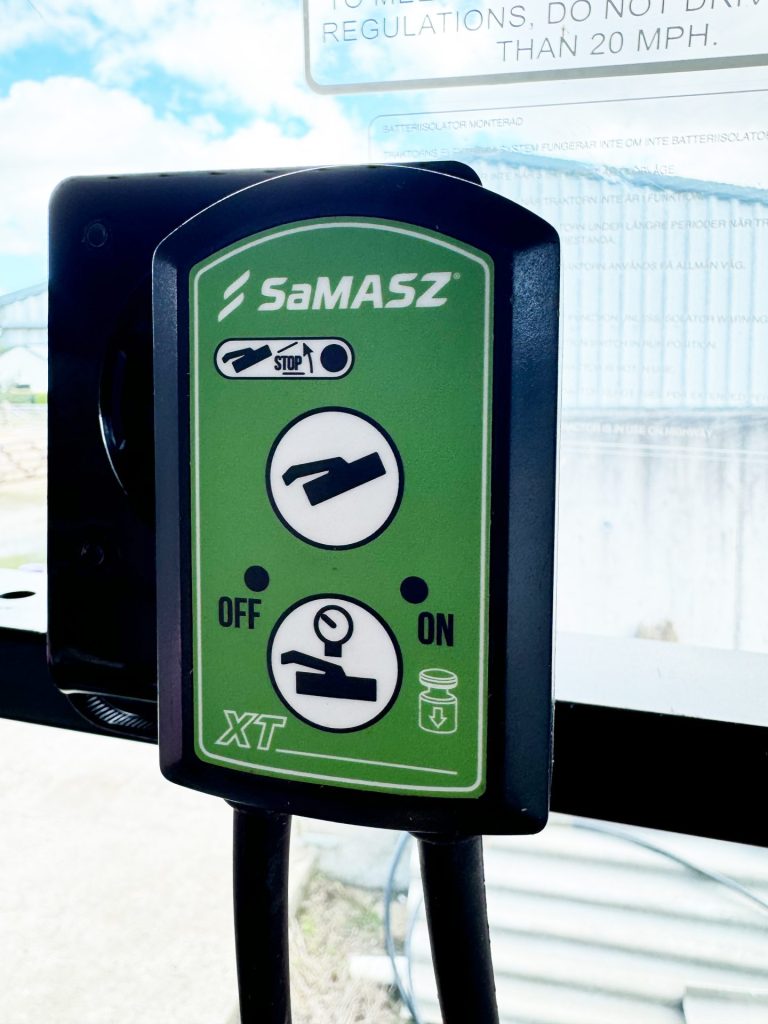If you want to drop grass with a modest amount of horsepower and are on a budget, then the simplistic Samasz front and back offering could be just the ticket. We’ve been using the front-mounted XT-F302 and rear XT340 combination this season to find out the good and bad.
KEEPING IT BRIEF
- Low power requirement. Our 125hp, six-cylinder was a good match.
- Front mower does a reasonable job of following ground contours.
- Price wise, in Ireland the XT-F302 is €12,661 and the XT340 is €19,550
Can you achieve more with less; less frills, less horsepower, less diesel and overall, less cost, but still get the job done? It is something that we’ve been pondering.
Take mowing, for instance. For farms doing their own silage and who know their ground, is there always a need for multi-dimensional suspension? Likewise, do you have to have a conditioner?
That crop conditioner conundrum is something only you can decide. Nonetheless we’re still intrigued with the ‘keeping it simple’ aspect of mowing grass. If you have a tractor with a front pto, then there are some big gains to be had by hitching on a front mower. Add GPS guidance, and suddenly headland turn times are massively reduced compared to working in bouts with just a rear mower.
Our rig for the season was a Samasz XT-F302 front and XT340 rear disc mower coupled to a six-cylinder Case IH Maxxum 125, which boosts to 165hp. Both of these mowers use the firm’s heavy-duty PerfectCut disc bed, the same cutterbar that also features in its larger triple conditioner mowers. So, although these are simple, they are by no means light duty. The models are also relatively new to the Samasz range, the XT-F replacing the Toro in 2022 while the rear XT arrived in 2019 as an entirely new line of sleeker looking central suspension mowers.

Fluffed up
Since both share the same cutterbar, we will discuss that now and chat about the mower’s other features later. This is Samasz’s own design with hardened 25mm thick gears transmitting power in the sealed, permanently lubricated bed. If you do happen to strike an object, the bed’s driveline is protected by a machined notch in each disc module. When it shears, then it is just a matter of whipping out several bolts and lifting out the hub to replace the sheared part. Then refit … and back to work.
Quick-change blades are standard on these machines, with each mower having its own tool and storage box for spares. The blade holder pins are made of hardened steel, and we have no complaints with knife edge life. There is a bit of an art to getting the tool correctly positioned to prise the quick-change open, but, once you get the knack, the blade swaps are quick and easy. The storage box keeps the left/right blades separate. Blade speed is in the region of 3,100rpm, with the usual 1,000rpm pto input for both mowers.
Samasz distributor for Ireland, Egmont Agri, who supplied the front and rear test combi, sent it with discs that have an instep; in fact it supplies these as standard on the range of plain disc mowers it sells. Compared to the normal smooth disc dome, these have lifting wedges that help to kick up the mown grass as it passes over the bed. These certainly leave a noticeably more fluffed up row than the normal flat swath you see with a plain mower, helping bring some of the lower stem to the top and allow air to circulate on light and medium cuts. They understandably made less of a difference in heavy grass crops. In our view the instep discs are worth having, as they make the grass easier to ted or rake; it’s not flat on the ground, in other words.
Row width is controlled by additional feeding drums or swathing discs. We didn’t have any issue with controlling the size of the swath, the drums on the front mower bringing the grass in enough that it could pass between the wheels. And the swathing disc on the rear XT has enough adjustment to keep the mowed grass away from the standing crop.
There is also a choice of wear-resistant skids for leaving a stubble up to 9cm or the double-high version, which increases this to 12cm.



Up front…
There is not a lot of difference between the previous Toro 302 and the XT-F302. Indeed it was more of a name change to emphasise partnering it with the rear-mounted XT than a full hardware revamp. It’s a straightforward push-type front mower that doesn’t put a lot of demands on the tractor, weighing in at 790kg and needing 1,000rpm pto. There are no hydraulic requirements, as it’s lifted and lowered on the tractor’s front linkage.

It is coupled up using an A-frame, but we can’t see any real benefit for this when used with modern tractors with external raise/lower buttons for the lift arms. Indeed, the A-frame is a bit of a hinderance as there is no holder for the uncoupled pto shaft, which ends up just sitting on the ground. Secondly, the clip that holds the frame-retaining pin did go missing but was thankfully spotted in time. We can see more merit in a fixed headstock.


As we mentioned the pto, this is a Walterscheid supplied unit with the grooved covers, so it doesn’t require a chain at the tractor end. There is a slip clutch for added protection. Tightening the two bolts that hold the pto on at the mower end is a challenge, as there is only one point of access on the side of the mower’s plastic cone cover. Ideally there’d be two, so you can hold the bolt at one side and the nut at the other when fitting.
When mowing, the tractor’s lift arms are left in float. Suspension is provided by coil springs attached to the headstock and tractor. Samasz supplies an array of brackets to fit to the tractor if you do not already have a suitable anchoring point. There are storage hooks for the springs when the machine is parked. All good so far.


The XT-F mower swings on a central pivot for lateral contour following. Three springs are used to balance the mower (two on the right to counterbalance the weight of the gearbox on the left) when it is raised out of work.
Tarp protective covers are held in place with a combination of twist lock clips and straps. We would question the long-term reliability of the twist clips, some of which were already showing signs of rust. Several of these clips also need to be opened when lifting the front panel for better access to the bed. If you find the skirt is pushing the grass down, then there is a second height setting.
The fold-down side guards are made of metal, making them nice and sturdy, but there are no protective hoops if the operator gets a little too close to a fence post.
A neat idea are the bungee cords that stop the folded side skirts flapping when on the road.
Less good are the two clips on each side that have to be removed/refitted when moving the side guards from their work to transport position — a less fiddly solution like a spring-loaded pin would be preferable, and, as it happens, this is something that Samasz will be introducing very shortly.

…and around the back
The XT340 is the smaller of two models (the XT390 has an extra disc so it covers 3.90m) having a working width of 3.40m. It ticks a lot of boxes, folding over centre so it is better balanced in its transport position and sits below 4.00m. It also has a centre pivot for lateral contour following, while the hydro-pneumatic suspension is a neater arrangement than the springs used on the KT range.

Four parking stands, one on each corner, allow the XT to be removed in its folded position. Each stand has to be separately raised and lowered with a choice of holes for the pins to sit in. Even when removed on a stone yard, the parked mower remains stable.

The XT headstock comes with both Cat II and III attachment points to suit different tractors. The pto shaft on the rear unit is sourced from Bondioli and Pavesi and, thanks to a removable guard, is easy to attach to the mower’s gearbox. Hydraulics wise, you only need one double-acting supply, and the pipes are fitted with Kennfixx grips for better handling. A simple electric control box then allows you to swap between three functions: setting the pressure in the hydro-pneumatic suspension; and then changing between raise/lower for field and transport. LED lights on the controller show you which function is selected.
A magnet on the back of the controller makes it easier to mount within the cab. It works well: you just need to remember to press the button to limit the lift height when in the field. Likewise, there is nowhere to sensibly store the controller on the mower. So, if you are switching between different mowing tractors, you need to remember where you left the disconnected box.
The bed pressure in the hydro-pneumatic system is shown on a gauge on the front of the headstock. To ensure that the tractor’s lift arms are at the correct height, there are two red pointers that you just need to align. Like the rest of the XT … simple and effective.

The rear mower uses the same canvas guards and steel end guard, with, not surprisingly, the same shortcomings already discussed with the front mower.


Reasonable work
Considering the limitations of the XT-F front mower’s suspension, it did an effective job, providing enough movement to flow over dips and hollows. While on the rear mower, one thing we noticed is that it works best with a short top link to give a clean cut.
Power wise, the Samasz combination was a good match to the Maxxum, which tended to remain in the 8-14km/hr speed band. If you stepped up the mowing pace, this is where the response reaction time of the mower’s limited suspension set-up could be called into question. Yet, even so, with an overall working width of 6.20m (minus the return pass overlap), it was a real eye opener as to how much of a difference adding a front mower could make to our mowing output for a modest outlay.

Other details
- The XT comes with a road light for the rear right as standard, as the folded mower blocks the tractor. Road lights are an option on the XT-F.
- The position of the top gearbox on the left- hand side of the XT-F is in the line of sight for marrying up the edge of the mower with the crop. If it were on the right-hand side you’d have a better view, especially if you open a field with the front mower on the outside.
- Headland lift-out height was not an issue for either mower.
- Hydraulic activated end guard folding is not an option.
- Paint finish and general build quality is very good, though Samasz is now rolling out its new colour scheme with the cream replaced by grey.
Summary
When chatting with Samasz importer Egmont Agri on how to drop more grass quickly with only modest horsepower, the firm’s suggestion was to try the XT-F front and XT rear mower combination. The 3.05m front and 3.40m rear proved to be a good pairing for our 125hp (boost 165hp) tractor, which was cutting up to 6.20m on each pass. Indeed, we pulled into a 10ha field, and a little less than two hours later we were heading back out of the gate without breaking much of a sweat.
If you have more horsepower on tap and want to drive faster, then you will expose the limits of the simple suspension; after all, there is a reason why manufacturers have developed more sophisticated offerings. Another plus for the combination we tested is that it made the outfit relatively light. In early first cut, where the heavy clay could best be described as tender, we were not leaving much of a mark beyond the treads of the tyres. And the front mower meant we were putting in fewer turns on the headland, too.
So, to answer our original question, yes you can still get the job done with less. Will it be for everyone? Perhaps not. But if you have a modest-sized tractor with a front pto, then it is certainly worth considering.
Mervyn Bailey
For more up-to-date farming news click here and subscribe now to profi and save.






